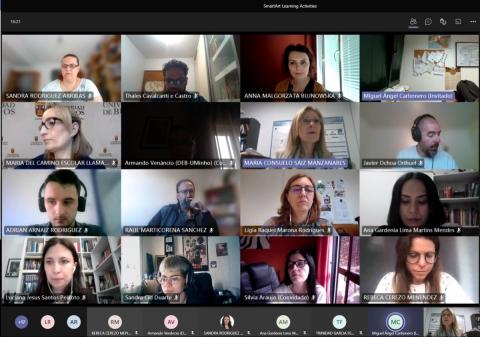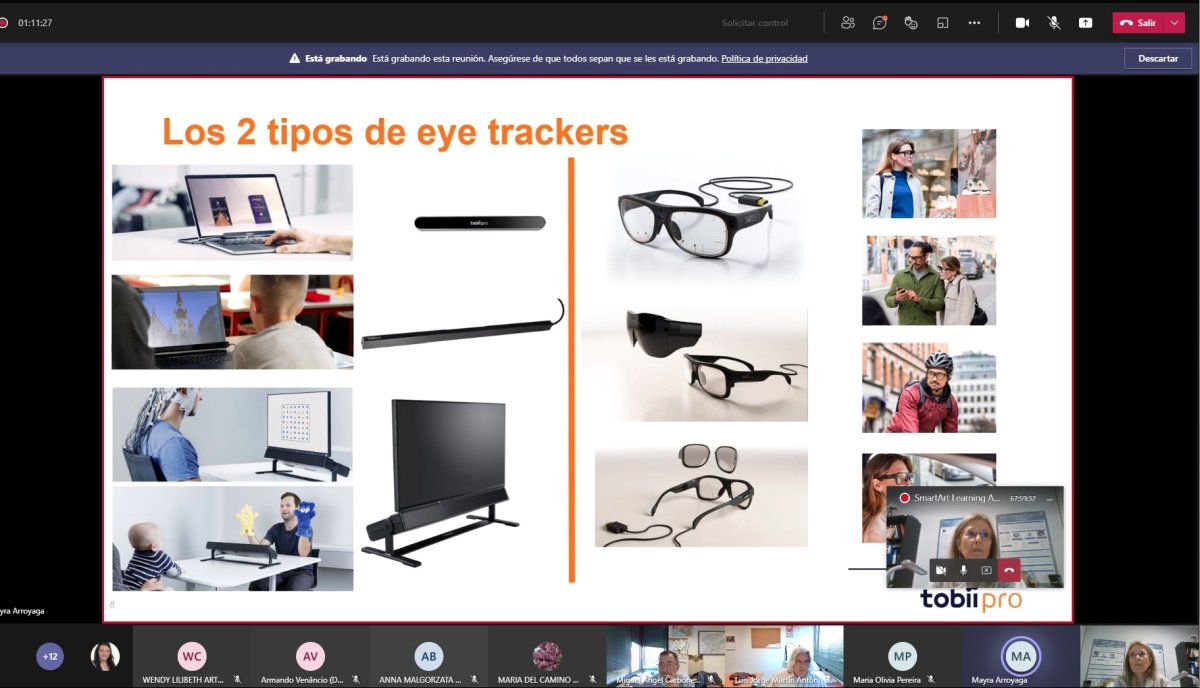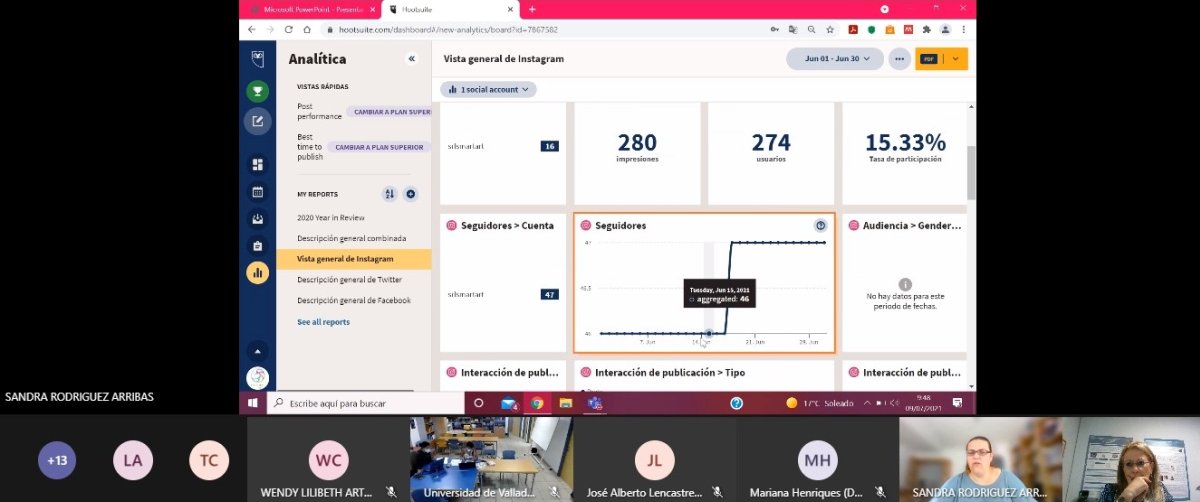Training in digital competences
13 Jul 2021

The SmartArt project has held the Learning Activites conference, which will continue in September. The researchers are designing a training activity focused on the use of technological advancement and data mining techniques. The SmartArt project led by the University of Burgos and co-funded by the European Erasmus+ programme has held the Learning Activities conference.
The coordinator of the project, PhD. María Consuelo Sáiz Manzanares from the University of Burgos, states that the training of teachers and students in innovative methodologies in virtual learning environments, together with the implementation of the resources offered by new technologies, is a challenge and a necessity in 21st century society, which has been accelerated by the COVID-19 pandemic. Moreover, this is one of the objectives of the European Union as set out in the standards of the European Framework for the Digital Competence of Educators (DigCompEdu).
The Learning Activities sessions, initially designed to be held in person at the University of Burgos, due to the restrictions caused by the COVID-19 health crisis, had to be held online using the UBUVIRTUAL training platform, the Teams videoconferencing tool and the use of a conversational voice assistant (Chatbot). Twenty-three professors and eleven university students from Spain, Portugal and Malta selected by the project partners from the universities of Burgos, Oviedo, Minho and Valladolid and members of the SME Paragon Europe have participated in these workshops.
The final objective of the project "Self-Regulated Learning in SmartArt Erasmus+ Adult Education 2019-1-ES01-KA204-095615-Coordinator 6 (SmartArt)" is to develop a learning methodology in virtual environments that includes intelligent tutoring systems to enhance motivation and autonomy in student learning. To this end, the project has used innovative teaching resources based on the use of project-based learning methodology, intelligent tutoring systems, process-oriented feedback through the use of avatars and serious games. These resources have been applied in an Intelligent Virtual Classroom (VLE) developed by the researchers. Three training courses are currently being developed in the VLE. The first is on learning about European cultural heritage, the monasteries, aimed at adults in non-formal education. The second Neuropsychology and neuropsychology at an early age, aimed at students of Health Sciences; and the third STEM subjects, learning the physics of movement, aimed at students of Secondary Education.
The training programme within the Learning Activities sessions was structured in five sessions coordinated by the University of Burgos.
In the first session, two presentations were given: "Project-based learning methodology in virtual environments" by PhD. María Consuelo Sáiz Manzanares and the second "How to design a VLE environment from a technological point of view" by Adrián Arnaiz Rodríguez.

The second session also included two presentations, the first "Design of learning materials based on gamification using an avatar" and the second "Proposals for the development of games in virtual environments" given by PhD. María José Zaparaín Yáñez.
The third session included a single presentation "Elaboration of rubrics in the SmartArt project" by PhD. María José Zaparaín Yáñez.
In the fourth session, three presentations were given: "Methods of evaluation of the learning process in virtual environments: introduction to eye tracking technology" by PhD. María Consuelo Sáiz Manzanares; "Practical activity with eye tracking technology" by Mayra Arroyaga, Account Manager Iberia Tobii and, finally, "An example of data processing in Advance Learning Technology (ALT)" by Adrián Arnaiz Rodríguez.
The Learning Activities ended with two other presentations, the first one "How to disseminate a European project in social networks" by Sandra Rodríguez Arribas and the second one by PhD. María Consuelo Sáiz Manzanares "How to disseminate research results in the media".
 During the sessions, the progress of the SmartArt project was presented, which focused on making materials and guidelines for developing a VLE available to attendees as practical implementation activities. The three courses currently included in the SmartArt VLE (monasteries, neuropsychology and physics of movement) were also analysed and the results of research into the use of eye tracking technology to study learning patterns in different types of students were presented. This work is being carried out in collaboration between the team of the University of Burgos (GIRs DATAHES and ADMIRABLE) and the team of the University of Oviedo (GIA ADIR). This collaboration has resulted in several publications in scientific journals of recognised prestige and dissemination at international scientific congresses.
During the sessions, the progress of the SmartArt project was presented, which focused on making materials and guidelines for developing a VLE available to attendees as practical implementation activities. The three courses currently included in the SmartArt VLE (monasteries, neuropsychology and physics of movement) were also analysed and the results of research into the use of eye tracking technology to study learning patterns in different types of students were presented. This work is being carried out in collaboration between the team of the University of Burgos (GIRs DATAHES and ADMIRABLE) and the team of the University of Oviedo (GIA ADIR). This collaboration has resulted in several publications in scientific journals of recognised prestige and dissemination at international scientific congresses.
After the training activity, an evaluation of the participants' satisfaction was carried out. The results indicate a high degree of satisfaction, highlighting the coordination of the activity (4.9 out of 5), the training agenda (4.7 out of 5), the presentations given (4.7 out of 5) and the atmosphere of participation (4.4 out of 5). In addition, the participants expressed their desire to continue with the training activity in order to deepen their knowledge of three of the aspects addressed at the conference: the design of a virtual learning environment, the use of eye tracking technology, and the automation of the analysis of dissemination in social networks through the use of the hootsuite tool.
In view of the interest aroused, a complementary training day will be held in September to address these aspects in more detail.
